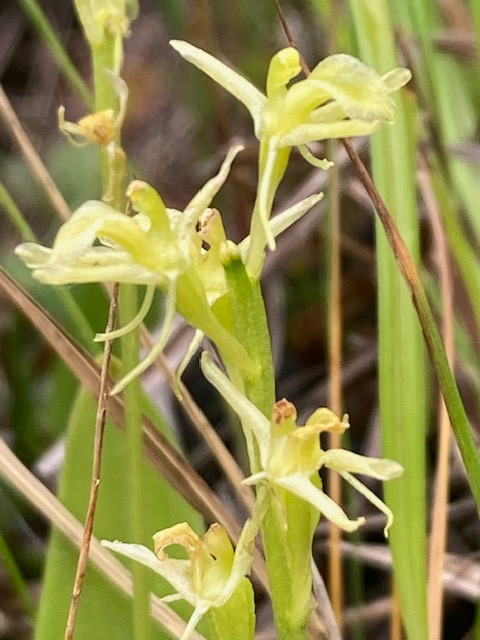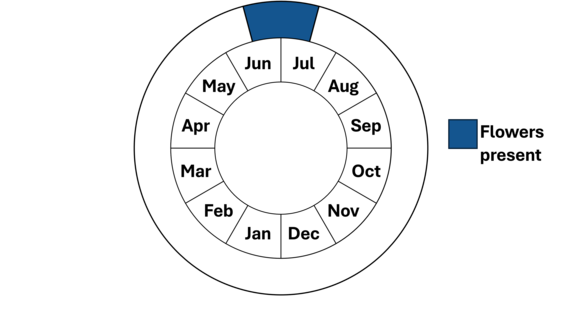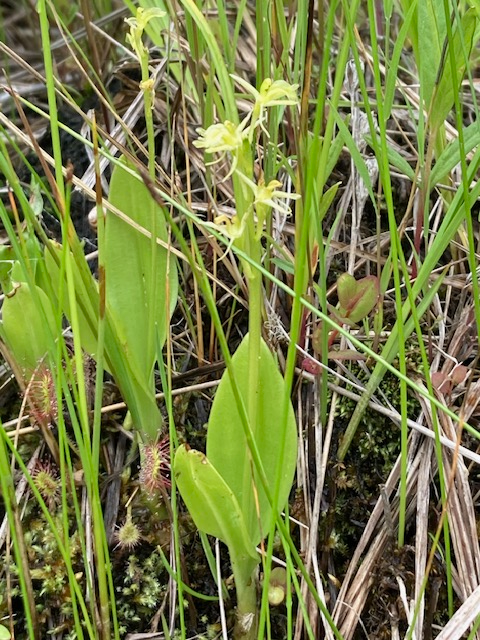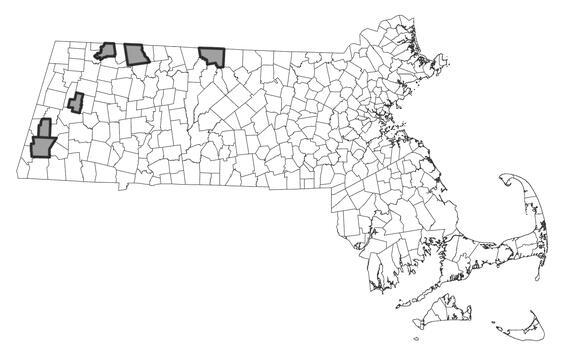- Scientific name: Liparis loeselii (L.) L.C. Rich
- Species of Greatest Conservation Need (MA State Wildlife Action Plan)
- Threatened (MA Endangered Species Act)
Description

Close-up of flowers. Photograph by Skye van der Laan
Loesel's Wide-lipped Orchid or Loesel's twayblade, Liparis loeselii, is a small perennial plant of the orchid family (Orchidaceae) found in wetlands. The name Liparis is derived from the Greek word for “greasy” or “oily” and refers to the appearance of the leaves of species in this genus; the species epithet “loeselii” honors Johannes Loesel (1607-1655), a German botanist and physician. Loesel’s twayblade can be as diminutive as 8 cm (3.2 inches) in height and as tall as 28 cm (11 inches). A pair of light to pale green, glossy, fleshy, elliptic to somewhat lanceolate leaves (4-17 cm long, 1-5 cm wide) ascend from the base of the plant and typically have a distinctive keel or mid-vein. The stem is slightly ridged along the length and holds the flowers well above the leaves. The numbers of flowers vary from two to twenty; they are pale yellow-green throughout. The somewhat inconspicuous flowers are delicate, with a distinctive downward curving lip or labellum. The ovary of the flower appears as if fused with the pedicel, which is 4-10 mm (roughly ¼ inch) in length at flowering time. The sepals and petals are somewhat threadlike.
Loesel's twayblade is similar in appearance to lily-leaf twayblade (Liparis liliifolia, Threatened) when only the leaves are present. The flowers are distinct as the labellum or lip of the lily-leaf twayblade is pale purple and quite flat, not curving or yellowish as in Loesel’s twayblade. The habitat for the Loesel’s twayblade is typically a wetland, while lily-leaf twayblade usually occurs in rocky dry forests.
Life cycle and behavior

Loesel’s twayblade is a perennial orchid and flowers in late June to mid-July. Interestingly, this species appears to be mostly self-pollinated with the assistance of raindrops falling on the pollen-bearing structures (pollinia). It forms ellipsoid, tan-colored capsules which mature in mid-October. The plant will over-winter as a pseudobulb (a bulbus structure on the stem below the leaves, that is used to store nutrients, air and water). The following spring a new stem will emerge adjacent to the previous year’s pseudobulb and will form a new pseudobulb. The seeds are small, extremely light and are spread by wind when the capsule opens. Seeds are thought to germinate in the spring with the aid of mycorrhizae fungi and often push up their first small leaves the following year. It may take several years (3 to 5) before the plant has the energy to produce a flowering stalk.
Population status

Whole plant in bloom. Photograph by Skye van der Laan.
Loesel’s twayblade is listed under the Massachusetts Endangered Species Act as threatened. All listed species are protected from killing, collecting, possessing, or sale and from activities that would destroy habitat and thus directly or indirectly cause mortality or disrupt critical behaviors. Historically, Loesel’s twayblade has been found in every county in Massachusetts except Suffolk. It currently is known from 6 populations in Berkshire, Franklin and Worcester Counties.
Distribution and abundance
Loesel's twayblade has a widespread but spotty distribution across northern North America ranging from Newfoundland Island south to North Carolina and Georgia then west to Washington and British Columbia. It is considered rare throughout most of its range: possibly extirpated in Washington state, critically imperiled in Alabama, Arkansas, Georgia, Illinois, Kansas, Kentucky, Maryland, Nebraska, North Carolina, South Dakota, and Tennessee. Several states also list it as imperiled and vulnerable. Loesel's twayblade also occurs in England and across continental Europe, Scandinavia, and Russia.
In New England, it is considered critically imperiled in Rhode Island, imperiled in Massachusetts and New Hampshire and vulnerable in Vermont. Neither Connecticut nor Maine have completed an assessment of the species.

Distribution in Massachusetts. 2000-2025. Based on records in the Natural Heritage Database.
Habitat
Loesel's twayblade is found most often in wetlands, especially calcium-rich fens, meadows and bogs. These can be habitats that are recovering from a past disturbance. McMaster (2001) found a sizeable population (over 200) in a wetland that had been excavated 20 years prior to his study. It is also found at the edges of lakes, ponds and streams, and sometimes in upland fields. It is likely that prior to European settlement, this species inhabited recently abandoned beaver ponds that had begun to re-grow vegetation.
Healthy habitats are vital for supporting native wildlife and plants. Explore habitats and learn about conservation and restoration in Massachusetts.
Threats
Although Loesel’s twayblade tolerates considerable natural disturbance, this must be episodic disturbance, not continual. It grows best where the water supply is kept constant, which means that disturbances to the natural hydrological regime will threaten this species. Additionally, deer will eat the plant, and invasive species at a site, such as reed canary grass and giant reed grass can crowd out this plant. It is likely that climate change with the widely variable precipitation and droughts predicted for the northeast will impact this species (Staudinger et al. 2024).
Conservation
Populations of Loesel’s twayblade tend to move around, though they may occur in appropriate habitats close to a previous observation. If surveying for this species it is important to survey all appropriate habitats near the previous observation. Loesel’s twayblade is best surveyed during late June and early July. Each plant is a separate genet.
The exact ecological needs of Loesel’s twayblade are not known. Management may include occasionally clearing of an area when populations have occurred in the past and maintaining appropriate habitats free of invasive plant species. All active management of rare plant populations (including invasive species removal) is subject to review under the Massachusetts Endangered Species Act and should be planned in close consultation with the MassWildlife’s Natural Heritage & Endangered Species Program.
Loesel’s twayblade requires an association with a mycorrhizae fungus to germinate. It is not known the exact needs of the fungi, whether this is one that is associated with trees or other species or with rotting material. Research is needed to determine the time this species takes from germination to maturity. It is thought to be a short-lived perennial.
References
Fernald, M. L. 1950. Gray’s Manual of Botany, Eighth (Centennial) Edition—Illustrated. American Book Company, New York.
Gleason, Henry A., and Arthur Cronquist. Manual of Vascular Plants of Northeastern United States and Adjacent Canada, Second Edition. Bronx, NY: The New York Botanical Garden, 1991.
Haines, A. 2011. Flora Novae Angliae – a Manual for the Identification of Native and Naturalized Higher Vascular Plants of New England. New England Wildflower Society, Yale Univ. Press, New Haven, CT.
McMaster, R.T. 2001. The Population Biology of Liparis Loeselii, Loesel’s twayblade, in a Massachusetts Wetland. Northeastern Naturalist 8, no. 2 (2001): 163–78.
NatureServe. 2025. NatureServe Network Biodiversity Location Data accessed through NatureServe Explorer [web application]. NatureServe, Arlington, Virginia. Available https://explorer.natureserve.org/. Accessed: 3/24/2025.
POWO (2025). "Plants of the World Online. Facilitated by the Royal Botanic Gardens, Kew. Published on the Internet; https://powo.science.kew.org/ Accessed: 3/24/2025."
Smith, Welby R. 2012. Native Orchids of Minnesota. University of Minnesota Press, Minneapolis MN.
Staudinger, M.D., A.V. Karmalkar, K. Terwilliger, K. Burgio, A. Lubeck, H. Higgins, T. Rice, T.L. Morelli, A. D'Amato. 2024. A regional synthesis of climate data to inform the 2025 State Wildlife Action Plans in the Northeast U.S. DOI Northeast Climate Adaptation Science Center Cooperator Report. 406 p. https://doi.org/10.21429/t352-9q86
Contact
| Date published: | April 30, 2025 |
|---|